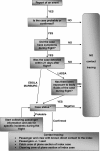Guidance for contact tracing of cases of Lassa fever, Ebola or Marburg haemorrhagic fever on an airplane: results of a European expert consultation
- PMID: 23170851
- PMCID: PMC3533809
- DOI: 10.1186/1471-2458-12-1014
Guidance for contact tracing of cases of Lassa fever, Ebola or Marburg haemorrhagic fever on an airplane: results of a European expert consultation
Abstract
Background: Travel from countries where viral haemorrhagic fevers (VHF) are endemic has increased significantly over the past decades. In several reported VHF events on airplanes, passenger trace back was initiated but the scale of the trace back differed considerably. The absence of guidance documents to help the decision on necessity and scale of the trace back contributed to this variation.This article outlines the recommendations of an expert panel on Lassa fever, Ebola and Marburg haemorrhagic fever to the wider scientific community in order to advise the relevant stakeholders in the decision and scale of a possible passenger trace back.
Method: The evidence was collected through review of published literature and through the views of an expert panel. The guidance was agreed by consensus.
Results: Only a few events of VHF cases during air travel are reported in literature, with no documented infection in followed up contacts, so that no evidence of transmission of VHF during air travel exists to date. Based on this and the expert opinion, it was recommended that passenger trace back was undertaken only if: the index case had symptoms during the flight; the flight was within 21 days after detection of the event; and for Lassa fever if exposure of body fluid has been reported. The trace back should only be done after confirmation of the index case. Passengers and crew with direct contact, seat neighbours (+/- 1 seat), crew and cleaning personal of the section of the index case should be included in the trace back.
Conclusion: No evidence has been found for the transmission of VHF in airplanes. This information should be taken into account, when a trace back decision has to be taken, because such a measure produces an enormous work load. The procedure suggested by the expert group can guide decisions made in future events, where a patient with suspected VHF infection travelled on a plane. However, the actual decision on start and scale of a trace back always lies in the hands of the responsible people taking all relevant information into account.
Figures

References
-
- ACI World Airport Traffic Report 2010. www.aci.aero.
-
- UNWTO: Tourism Market Trends, 2006 Edition – Annex. http://www.unwto.org/facts/eng/pdf/indicators/ITA_africa.pdf.
-
- Sidley P. Fears over Ebola spread as nurse dies. BMJ. 1996;313(7069):1351. - PubMed
-
- Beeching NJ, Fletcher TE, Hill DR, Thomson GL. Travellers and viral haemorrhagic fevers: what are the risks? Int J Antimicrob Agents. 2010;36(Suppl 1):S26–S35. - PubMed
-
- Leitmeyer K. European risk assessment guidance for infectious diseases transmitted on aircraft--the RAGIDA project. Euro Surveill. 2011;16(16) pii: 19845. - PubMed
Publication types
MeSH terms
LinkOut - more resources
Full Text Sources
Medical
Miscellaneous

